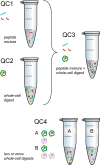Quality Control in the Mass Spectrometry Proteomics Core: A Practical Primer
- PMID: 40331211
- PMCID: PMC12051443
- DOI: 10.7171/3fc1f5fe.42308a9a
Quality Control in the Mass Spectrometry Proteomics Core: A Practical Primer
Abstract
The past decade has seen widespread advances in quality control (QC) materials and software tools focused specifically on mass spectrometry-based proteomics, yet the rate of adoption is inconsistent. Despite the fundamental importance of QC, it typically falls behind learning new techniques, instruments, or software. Considering how important QC is in a core setting where data is generated for non-mass spectrometry experts and confidence in delivered results is paramount, we have created this quick-start guide focusing on off-the-shelf QC materials and relatively easy-to-use QC software. We hope that by providing a background on the different levels of QC, different materials and their uses, describing QC design options, and highlighting some current QC software, implementing QC in a core setting will be easier than ever. There continues to be development in each of these areas (such as new materials and software), and the current generation of QC for mass spectrometry-based proteomics is more than capable of conveying confidence in results as well as minimizing laboratory downtime by guiding experimental, technical, and analytical troubleshooting from sample to results.
Keywords: best practices; materials; proteomics; quality control; software; standards.
Copyright © 2024 Association of Biomolecular Resource Facilities. All rights reserved.
Conflict of interest statement
Competing Interests: The authors declare no competing interests.
Figures

Similar articles
-
Prescription of Controlled Substances: Benefits and Risks.2025 Jul 6. In: StatPearls [Internet]. Treasure Island (FL): StatPearls Publishing; 2025 Jan–. 2025 Jul 6. In: StatPearls [Internet]. Treasure Island (FL): StatPearls Publishing; 2025 Jan–. PMID: 30726003 Free Books & Documents.
-
The Black Book of Psychotropic Dosing and Monitoring.Psychopharmacol Bull. 2024 Jul 8;54(3):8-59. Psychopharmacol Bull. 2024. PMID: 38993656 Free PMC article. Review.
-
Health professionals' experience of teamwork education in acute hospital settings: a systematic review of qualitative literature.JBI Database System Rev Implement Rep. 2016 Apr;14(4):96-137. doi: 10.11124/JBISRIR-2016-1843. JBI Database System Rev Implement Rep. 2016. PMID: 27532314
-
A rapid and systematic review of the clinical effectiveness and cost-effectiveness of paclitaxel, docetaxel, gemcitabine and vinorelbine in non-small-cell lung cancer.Health Technol Assess. 2001;5(32):1-195. doi: 10.3310/hta5320. Health Technol Assess. 2001. PMID: 12065068
-
Interventions to reduce harm from continued tobacco use.Cochrane Database Syst Rev. 2016 Oct 13;10(10):CD005231. doi: 10.1002/14651858.CD005231.pub3. Cochrane Database Syst Rev. 2016. PMID: 27734465 Free PMC article.
Cited by
-
QSample: An Automated System for Rapid Monitoring of Quality Indicators in Proteomics Samples.J Proteome Res. 2025 Sep 5;24(9):4816-4824. doi: 10.1021/acs.jproteome.5c00119. Epub 2025 Aug 19. J Proteome Res. 2025. PMID: 40827108 Free PMC article.
References
Publication types
MeSH terms
LinkOut - more resources
Full Text Sources
Miscellaneous
